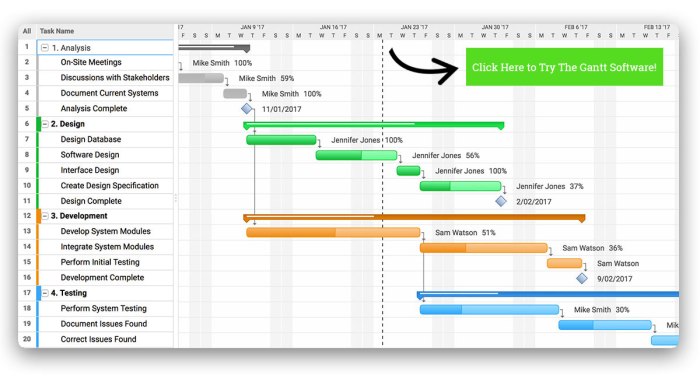Gantt Project Planner: Mastering project timelines has never been easier! This guide dives into the world of Gantt charts, showing you how to leverage their power for effective project management. We’ll cover everything from the basics of creating a Gantt chart to advanced techniques like critical path analysis, ensuring you’re equipped to tackle any project, big or small.
We’ll explore different types of Gantt project planners – from free online options to robust paid desktop software – helping you choose the perfect tool for your needs. Get ready to visualize your project’s timeline, manage resources efficiently, and track progress with confidence.
This isn’t just about scheduling tasks; it’s about gaining control and achieving your project goals.
Using Gantt Project Planners for Project Management

Gantt charts are the unsung heroes of project management, transforming complex timelines into easily digestible visual representations. They offer a clear, concise overview of tasks, deadlines, and dependencies, allowing project managers to maintain control and anticipate potential roadblocks before they derail the entire project.
Think of them as a roadmap, but instead of showing geographical locations, they chart the progress of your project through time.
Gantt charts provide a bird’s-eye view of a project’s schedule, allowing for quick identification of critical paths, potential delays, and resource allocation issues. Their visual nature makes them invaluable for communication, enabling project managers to easily share the project status with stakeholders, fostering transparency and collaboration.
Creating a Basic Gantt Chart, Gantt project planner
Constructing a Gantt chart is surprisingly straightforward. The process involves a few key steps that, once mastered, will empower you to manage even the most intricate projects.
First, you’ll need to define the project scope. This involves breaking down the project into smaller, manageable tasks. Next, you’ll estimate the duration of each task. Then, you’ll determine the dependencies between tasks – which tasks need to be completed before others can begin.
Finally, you’ll input this information into your chosen Gantt chart software (many free and paid options exist) or even create a simple one by hand. The software will automatically generate the chart, visually displaying the tasks as horizontal bars, their lengths representing their durations, and their positions reflecting their start and end dates.
Dependencies are often shown with arrows connecting related tasks.
Adding Tasks, Dependencies, and Milestones
Once the basic framework is in place, the power of the Gantt chart truly unfolds. Adding tasks, dependencies, and milestones enhances the chart’s ability to provide a comprehensive project overview.
Adding tasks is simply a matter of inputting the task name and its estimated duration into the software. Dependencies are crucial; they illustrate the order in which tasks must be completed. For example, “Write the report” is dependent on “Conduct the research.” Milestones represent significant achievements within the project, such as the completion of a phase or the delivery of a key deliverable.
They are typically marked with a diamond or other distinctive symbol on the chart.
Sample Project Plan: Website Redesign
Let’s illustrate this with a sample project. This example demonstrates how a Gantt chart can effectively organize and visualize a website redesign project. The careful planning highlighted here reduces the likelihood of project delays.
The following bullet points Artikel the tasks, durations, and dependencies for a website redesign project. Note that these durations are estimates and could vary based on the project’s complexity and team size.
- Task:Conduct User Research & Analysis; Duration:5 days; Dependencies:None
- Task:Design Wireframes; Duration:3 days; Dependencies:Conduct User Research & Analysis
- Task:Develop Design Mockups; Duration:7 days; Dependencies:Design Wireframes
- Task:Develop Front-End Code; Duration:10 days; Dependencies:Develop Design Mockups
- Task:Develop Back-End Code; Duration:10 days; Dependencies:Develop Design Mockups
- Task:Conduct Testing & Quality Assurance; Duration:5 days; Dependencies:Develop Front-End Code, Develop Back-End Code
- Task:Deploy Website; Duration:1 day; Dependencies:Conduct Testing & Quality Assurance
Final Review: Gantt Project Planner
By now, you should feel confident in your ability to harness the power of a Gantt project planner. Remember, a well-crafted Gantt chart isn’t just a visual representation of your project; it’s a dynamic tool for planning, tracking, and ultimately, succeeding.
From simple tasks to complex projects, a Gantt chart provides the clarity and control you need to stay on track and deliver exceptional results. So go ahead, chart your course to success!
